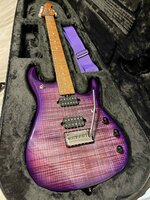Buck_weat
New member
Hello everyone! I know this is a super-basic question, but I am having trouble tuning my guitar. I have never had one with a floating bridge before this one. When I tune it, I start on the low E string and go to the high E string. But when I go back to the low E and check those lower strings are flat. I keep chasing this back and forth. I know there has to be a better way. Is there a certain string order I need to follow? Thanks in advance for your help!
Here is a pic of the guitar - I also posted it in the picture section.

Here is a pic of the guitar - I also posted it in the picture section.



